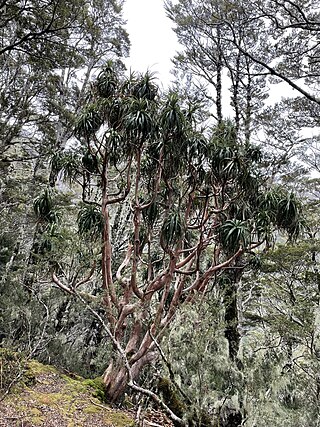
Pseudowintera is a genus of woody evergreen flowering trees and shrubs, part of family Winteraceae. The species of Pseudowintera are native to New Zealand. Winteraceae are magnoliids, associated with the humid Antarctic flora of the southern hemisphere. Horopito can be chewed for a hot, peppery taste.

Pimelea, commonly known as rice flowers, is a genus of plants belonging to the family Thymelaeaceae. There are about 150 species, including 110 in Australia and 36 in New Zealand.

Ugni molinae, commonly known as Chilean guava berry, or strawberry myrtle, is a shrub native to Chile and adjacent regions of southern Argentina. The local Spanish name is murta, and the Mapuche Native American name is "Uñi" or Uñiberry. It is in the same botanical family as the guava.

Dracophyllum is a genus of plants belonging to the family Ericaceae, formerly Epacridaceae. There are 61 species in the genus, mostly shrubs, but also cushion plants and trees, found in New Zealand, Australia, Lord Howe Island and New Caledonia. The name Dracophyllum, meaning dragon-leaf, refers to their strong outward similarity to the unrelated Dracaena, sometimes known as dragon tree. Although dicotyledonous, they resemble primitive monocots with their slender leaves concentrated in clumps at the ends of the branches; they are sometimes called grass-trees.

Veronica traversii, synonym Hebe traversii, is an ornamental plant of the family Plantaginaceae. It is endemic to the south island of New Zealand. The specific epithet traversii is in honor of naturalist Henry H. Travers (1844-1928), son of William Thomas Locke Travers.
Henry Hammersley Travers was a New Zealand naturalist, professional collector and taxidermist. He was the son of the politician William Travers.

Archeria is a small genus of shrubs in the family Ericaceae. As currently circumscribed the group includes six species, all native to southern Australasia. Four of these are endemic to Tasmania, and the other two endemic to New Zealand.

Archeria traversii is a species of shrub in the family Ericaceae.

Pimelea ligustrina is a species of flowering plant in the family Thymelaeaceae, and is endemic to south-eastern Australia. It is a shrub with lance-shaped or narrowly elliptic leaves arranged in opposite pairs, and clusters of creamy-white, white or pinkish flowers usually surrounded by 4 or 8, greenish to reddish brown involucral bracts.
Pimelea gnidia is a species of small shrub in the family Thymelaeaceae. It is endemic to New Zealand. According to the New Zealand Threat Classification System (NZTCS), it is not threatened as of 2012.
Pimelea virgata is a species of small shrub, of the family Thymelaeaceae. It is native to Australia.

Pimelea prostrata, commonly known as Strathmore weed, New Zealand Daphne, and Pinatoro (Māori) is a species of small shrub, of the family Thymelaeaceae. It is endemic to New Zealand and has small white flowers and blue green leaves.

Pimelea lyallii, commonly known as the southern sand daphne, is a species of small shrub of the family Thymelaeaceae.

Pseudowintera traversii, sometimes called Travers horopito, is a species of woody shrub in the family Winteraceae. The specific epithet traversii is in honor of naturalist Henry H. Travers (1844–1928), son of William Thomas Locke Travers.
P. traversii may refer to a two different species of shrub. The specific epithet traversii refers to someone with the surname 'Travers,' in these cases it's New Zealand naturalist Henry H. Travers (1844–1928).

Dracophyllum traversii, commonly known as mountain neinei, grass tree, and pineapple tree is a species of flowering plant in the heath family Ericaceae. It is a deciduous tree endemic to New Zealand. It reaches a height of 0.2–13 m (0.66–42.65 ft) and has leaves which form tufts at the end of its branches. It has a lifespan of between 500 and 600 years.

Dracophyllum fiordense, commonly known as the Fiordland grass tree, is a species of tree or shrub in the heath family, Ericaceae. It is endemic to the South Island of New Zealand. It reaches a height of 1.5–5.0 metres and has tufts of long green leaves at the ends of its branches. Each leaf has a distinctive curled spiral tip. D. fiordense has a pyramid-shaped inflorescence hidden under each clump of leaves, with between 113 and 120 pink flowers on each spike, and later reddish-brown dry fruit; both are around just 2 by 2 mm. It inhabits shrubland, lowland and subalpine forests, and tussock grassland of mountain slopes, gullies, and ridges. Its range covers two main areas: one in Fiordland National Park, and one in the Mount Cook and Westland National Parks.

Myosotis traversii is a species of flowering plant in the family Boraginaceae, endemic to the South Island of New Zealand. Joseph Dalton Hooker described this species in 1864. Plants of this species of forget-me-not are perennial rosettes which form tufts or clumps, with ebracteate, erect inflorescences, and white or yellow corollas with partly exserted stamens.

Myosotis traversiisubsp. traversii is a subspecies of flowering plant in the family Boraginaceae, endemic to the northern South Island of New Zealand. Joseph Dalton Hooker described the species M. traversii in 1864. Plants of this subspecies of forget-me-not are perennial rosettes which form tufts or clumps, with ebracteate, erect inflorescences, and white or yellow corollas with partly exserted stamens.
Pimelea drummondii is a species of flowering plant in the family Thymelaeaceae and is endemic to near-coastal areas of southern Western Australia. It is an erect, slender shrub with narrowly elliptic or elliptic leaves arranged in opposite pairs, and white or cream-coloured flowers surrounded by 3 or 4 pairs of pale green to yellowish involucral bracts.














